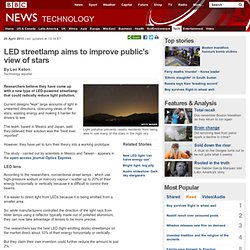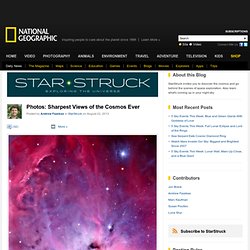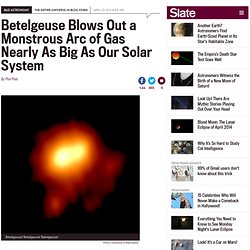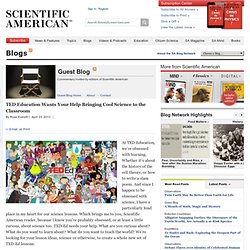

HSC. Astrophysics. Telescopes. Light pollution. LED streetlamp aims to improve public's view of stars. 25 April 2013Last updated at 13:14 ET By Leo Kelion Technology reporter Light pollution prevents nearby residents from being able to see many of the stars in the night sky Researchers believe they have come up with a new type of LED-powered streetlamp that could radically reduce light pollution.

Current designs "leak" large amounts of light in unwanted directions, obscuring views of the stars, wasting energy and making it harder for drivers to see. The team, based in Mexico and Japan, said they believed their solution was the "best ever reported". However, they have yet to turn their theory into a working prototype. The study - carried out by scientists in Mexico and Taiwan - appears in the open-access journal Optics Express. LED lens According to the researchers, conventional street lamps - which use high-pressure sodium or mercury vapour - scatter up to 20% of their energy horizontally or vertically because it is difficult to control their beams. LED revolution.
Photos: Sharpest Views of the Cosmos Ever. A close-up of the central region of the Orion nebula, taken with the Schulman Telescope at the Mount Lemmon SkyCenter.

Credit: Adam Block/UA SkyCenter) Astronomers have built a new astro-camera that, when fitted onto the largest observatories on Earth, can snap photos of the universe twice as sharp as the famed Hubble Space Telescope. With the newly developed technology, giant telescopes can reach their theoretical limits of resolution in visible light —something that was just not possible, until now, because of atmospheric turbulence causing blurry visible light images. (Related: The Largest Baby Star, Ever?) “It was very exciting to see this new camera make the night sky look sharper than has ever before been possible,” said Laird Close, the project’s principal scientist at the University of Arizona in a press statement. “As a result, we can see the visible sky more clearly than ever before,” said Close.
Einstein's gravity theory passes toughest test yet. A strange stellar pair nearly 7,000 light-years from Earth has provided physicists with a unique cosmic laboratory for studying the nature of gravity.

The extremely strong gravity of a massive neutron star in orbit with a companion white dwarf star puts competing theories of gravity to a test more stringent than any available before. Once again, Albert Einstein's General Theory of Relativity, published in 1915, comes out on top. At some point, however, scientists expect Einstein's model to be invalid under extreme conditions. General Relativity, for example, is incompatible with quantum theory. Physicists hope to find an alternate description of gravity that would eliminate that incompatibility. A newly-discovered pulsar -- a spinning neutron star with twice the mass of the Sun -- and its white-dwarf companion, orbiting each other once every two and a half hours, has put gravitational theories to the most extreme test yet.
Preliminary. 8.5 The Cosmic Engine. Betelgeuse: Red supergiant blasts out arc of material billions of miles long. Photo: University of Manchester The famous star, marking the shoulder of Orion, is a red supergiant, a massive and massively swollen star.

It’s ridiculously huge; if you replaced the Sun with Betelgeuse it would stretch out nearly to the orbit of Jupiter. It’s also near the end of its life. Someday, probably within the next million years or so, it’ll explode, becoming a supernova, and shining about as bright as the moon in our sky. Mind you, it’s 640 light years—6.4 quadrillion kilometers—away. And new observations of it show that it’s weirder than previously thought. For one, the outer atmosphere (which is where the radio waves from the star originate) stretches out a full five times larger than the star’s surface in visible light. But it’s that arc of material to the lower right that makes the hair on the back of my neck stand up. Betelgeuse is dying. 8.5.4 Solar Activity. Beginning of universe - Ted Ed. At TED Education, we’re obsessed with learning.

Whether it’s about the history of the cell theory, or how to write a slam poem. And since I happen to be obsessed with science, I have a particularly fond place in my heart for our science lessons. Which brings me to you, Scientific American reader, because I know you’re probably obsessed, or at least a little curious, about science too. TED-Ed needs your help. What are you curious about? But first, let’s back up. Some of my favorite science lessons that we’ve done so far range from pizza physics, to the origins of the universe. This amazing and wacky animation takes you through the life and times of a blue whale.
Why do New Yorkers fold their pizza? In a partnership with CERN, we explored the origin of the universe. And this beautiful hand-made animation explains why cancer patients hair falls out – and how cancer works in general. 8.4 Moving About. 8.3 Electrical Energy in the Home. 8.2 The World Communicates. Refraction picture.